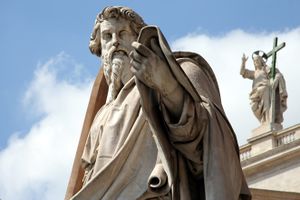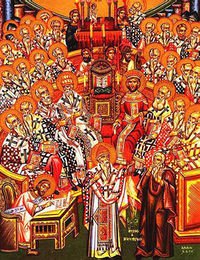Difference between revisions of "How were texts selected for the New Testament"
| Line 37: | Line 37: | ||
===References=== | ===References=== | ||
<References/> | <References/> | ||
| − | [[Category:Wikis]][[Category:History | + | [[Category:Wikis]][[Category:Religious History]][[Category:European History]] |
Revision as of 01:21, 25 June 2017
Many Christians throughout the world look to the bible, the New Testament specifically, as the sole authority for Christian life and teaching, but may not be aware of how this deeply influential and unique text came to be. Interestingly, there was no such thing as the “Bible” for, roughly, the first four centuries of Christianity.
What eventually became known as the “New Testament” was not ratified until a series of ecumenical councils, convened by the Catholic Church in the fourth and fifth centuries. These councils carefully considered potential testaments and epistles for inclusion in the canon (meaning, cane or straight) and were ultimately included or excluded based on their ability to meet these various criteria. In what follows, I will explain what texts are now included in the canon, how those texts where chosen, and what ecumenical councils were most pivotal in creating what is now known of the Christian New Testament.
What is in the New Testament?
The Christian New Testament is not written by one single author. Instead, the New Testament is made up of several unique and distinct texts, written by a variety of Christian disciples or scribes. First, the New Testament includes four narratives of the life of Jesus Christ, traditionally named Matthew, Mark, Luke and John.
Though throughout Christian history it was believed that each of these narratives was authored by Jesus’ disciples or their close followers, many contemporary critical scholars have concluded that the texts may have been written by scribes who were familiar with the Greek language. Many have reached this conclusion because it is unlikely that Jesus’ followers knew how to write in Greek, considering their modest background and upbringing. It is more likely that they dictated the information to scribes that translated their accounts into Greek to reach a more vast audience.
In addition to the four Gospel narratives, the New Testament also consists of The Acts of the Apostles, a number of epistles written mostly by Paul of Tarsus to various early Christian communities, and the Book of Revelation. The book of Acts is believed to be written by the same author who constructed Luke’s gospel narrative. Both books are addressed to the same person, Theophilus. Scholars are unsure whether Theophilus was an actual person or if the name is a metaphor for “friends of God,” which is the meaning of the name in the Greek.
The book of Acts recounts the activities of the early church from Pentecost (when the disciples received the Holy Spirit in Jerusalem) to Paul’s missionary journeys throughout the Mediterranean. Next, the epistles were letters written to early Christian communities as words of encouragement or theological instruction for moral living. A majority of the epistles are written by Paul of Tarsus, affectionately known as St. Paul in the Christian tradition. Among Paul’s most famous and recognized epistles are his letters to the Romans and the Corinthians (essentially those letters written to the churches in Rome, Italy and in Corinth, which is in modern day Greece). In addition to Paul’s letters there are also two letters from Peter, two letters from John and one letter from James. Lastly, the book of Revelation is an account of a dream of the beloved apostle, John. In this dream, or revelation, John explains his vision about the apocalypse or the end of times. The book of Revelation is understood as the most notoriously difficult to interpret, due to its symbolic and metaphorical complexity.
Inclusion Criteria
As Catherine Cory explains in her book, A Voyage through the New Testament, there are four inclusion criteria that affected the development of the New Testament canon: 1) apostolic origin 2) theological correctness 3) authority of the church leaders and 4) widespread appropriation of the churches.[1] So then, the books that were eventually chosen for inclusion in the canon met the aforementioned criteria as determined by the discernment of the ecumenical councils, which will be discussed later. For now, let us examine each of the four criteria.
The first, apostolic origin, is in regards to the authorship of each letter or narrative. In order for the book to be considered for inclusion in the canon it had to be written by one of the twelve apostles or someone who was a close disciple of the twelve apostles. Clearly, someone who lived and ministered in close proximity to Christ himself would have a narrative most aptly reflecting the actual events. The second criterion, theological correctness, depended largely on the early church’s conception of orthodoxy (straight teaching). What was the right teaching? Did the narrative in question reflect the right teaching or did it clash with the teaching of the apostles? Further, was the narrative or letter a hindrance to perpetuating belief in the Gospel or did it serve as a reinforcement for maintaining the faith? As one can see, this criterion was largely dependent upon a pre-existing tradition, which determined the right teaching.
The third criterion, authority of the church leaders, was not only influential in determining the orthodox teaching but also in picking the actual books which would be included in the canon. The books which are now in the New Testament were not voted in by the Christian populous (most Christians during this time were not even literate!), but were chosen by the church authorities, namely the bishops and other influential theological figureheads.
Lastly, in order for a given book to be included in the New Testament it had to be widely used by most Christian communities. Many of the gospel narratives and Pauline epistles were being circulated and copied by established Christian communities so they could be used in worship services. If a book was used by a majority of Christian communities and not just one isolated church, it would have positively affected its consideration for inclusion within the canon. Maintaining the universality of the Gospel was an important consideration, which is why this last criterion was most likely established.
When did Christians officially have a Bible?
Choosing the actual texts that now make up the New Testament was not a short or simple process. The deliberation spanned across several decades beginning with the council of Nicaea in 325, C.E. and ending with the Council of Carthage in 419 C.E., where a full list of the Old and New Testament canon was ratified.[2] Interestingly, although the canon was ratified in the third council of Carthage, it was not officially closed at this time, meaning that modifications could have been made had subsequent councils deemed it fit. However, during the Protestant Reformation the Catholic Church officially closed the canon of Scripture during the Council of Trent for fear that the book of Hebrews (an epistle of Paul’s) and the book of James may removed due to their seeming incompatibility with Luther’s doctrine of Sola Fide.
Conclusions
Ultimately, what Christians now call the New Testament was compiled by various authors who were either contemporaries of Christ or one generation removed from Christ. These texts were carefully deliberated by the church authorities according to their ability to meet the inclusion criteria discussed above. The Bible, as it is known today, was a product of serious deliberation among learned church authorities. Today, Christians debate on the exact medium of divine inspiration, but most Christians do believe that both the authors of each book and the process through which the books were chosen for inclusion in the canon were inspired by the Holy Spirit.
References
- ↑ Cory, Catherine. A Voyage Through the New Testament. (New Jersey: Pearson, 2008), 11.
- ↑ See: Canon 24, Council of Carthage, trans. Henry Percival. From Nicene and Post-Nicene Fathers, Second Series, Vol. 14. Edited by Philip Schaff and Henry Wace. (Buffalo, NY: Christian Literature Publishing Co., 1900.) Revised and edited for New Advent by Kevin Knight. newadvent.org



